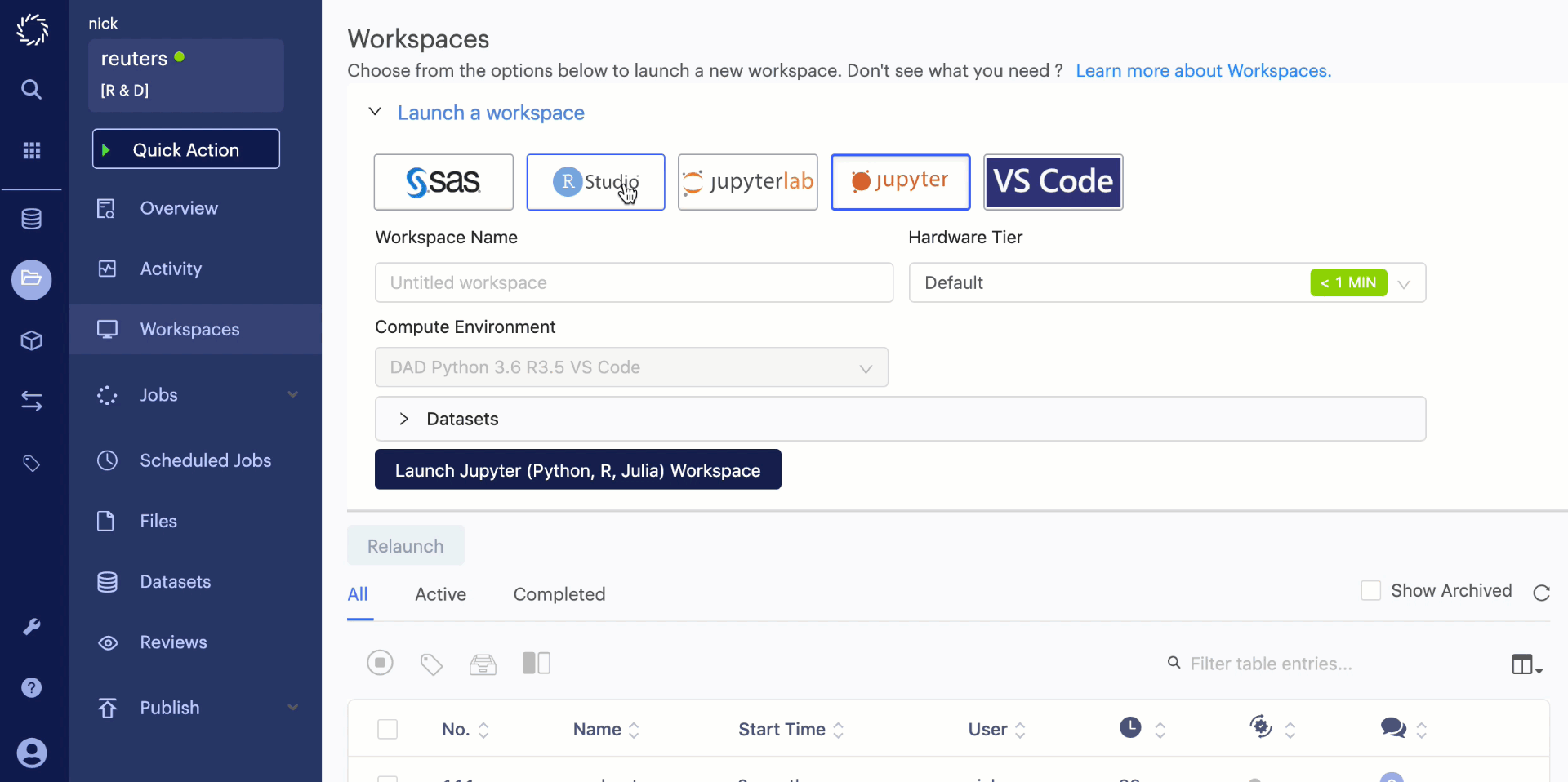- Independently access diverse tools and elastic compute resources in the cloud.
- Share expertise and resources. (At the time, the company’s 500-plus data scientists, researchers, and statisticians typically worked in silos.)
- Test different scenarios and reproduce results with ease. This is critical for patient safety and regulatory requirements, but also quite challenging. To reproduce a testing result, for example, the company has to capture and track numerous dependencies including:
- statistical analyses selected,
- scripts that implement the analyses,
- libraries that implement statistical functions and perform mathematical computations,
- operating system that runs the environment,
- data reduction processes,
- and the raw data chosen.
- Streamline workflows to productionize models more quickly and publish findings to more than 400 different “consumers.” These consumers include peers in different parts of the development process and a wide variety of internal and external partners who leverage this work in everything from documentation and validation to determining where to run their next marketing campaign for a specific drug.
Solution
The biopharmaceutical company deployed an FDA-qualified research system of record on Domino that enables researchers across the company to more quickly test hypotheses, reproduce results, build off past work, and submit their findings to the FDA. The environment is available to anyone in the company; active users represent translational medicine, observational research and data science, and business intelligence and analytics.
How does it work?
As researchers and data scientists begin their work, they use the Domino Workbench to quickly access: data sources; tools such as SAS, R, Python, PyTorch, Matlab, and a wide range of domain-specific tools; and compute resources in Amazon Web Services.

Standardized configured environments are available via a shared catalog, providing a one-stop approach for users to get up and running for typical data science workflows. Data scientists can also quickly view a snapshot of curated data pipelines and previous analyses that exist as they begin their work, in case there’s something that can be repurposed for their needs.
All code, data, tools, and packages used during research and development (R&D) are automatically tracked, along with any comments and annotations, so users can quickly reproduce results, build off existing work by others, and share ideas. This capability not only accelerates research but also helps ensure that valuable intellectual property isn’t lost when employees leave the company. Additionally, this reproducibility is foundational to improving chemical development and manufacturing processes, which require highly precise and sophisticated procedures to document every stage of the process, optimize ideal reaction conditions, and provide full accountability of any changes.
Domino drives documentation as a code process, making it easy for researchers and data scientists to package up all relevant information in a Domino API when they’re ready to submit results to the FDA
The company took a phased approach toward its Domino implementation, onboarding 15 teams one at a time based on their prioritized compute needs and readiness to adopt. As part of deployment, Domino provided subject matter expertise and configuration, application migration and user support, along with internal training and resources to help users get up and running on the new platform quickly.
Use Case: Cancer Research
According to the American Cancer Society, in 2020 there will be an estimated 1.8 million new cancer cases diagnosed and 606,520 cancer deaths in the United States alone. Data science is vital for finding connections in data that will help improve patient outcomes and prevent cancer. One key goal of this biopharmaceutical company’s research is to improve the understanding of the relationship between genetic changes, such as DNA mutations that drive tumor formation, and how cancer cells exploit immune checkpoints to sabotage a patient’s immune system. Today, using its Domino research platform, the company can analyze data from more than 10,000 tumors to uncover possible connections. This work has led to discoveries critical in expanding survival rates for patients, including:
- Identification of new classes of drugs that can infiltrate tumors and the ability to correlate their impact on each individual, which help doctors identify which specific therapies offer the best outcomes for each patient.
- New insight into how the immune system responds to cancer cells, including the discovery of a specific chromosome that can impact immunity to cancer cells.
The Domino Effect
- Driving discoveries: With the help of Domino’s platform, researchers can track and trace reams of genomic data aggregated from thousands of tumor samples. And they can successfully test tens of thousands of hypotheses with complete reproducibility, all to accelerate their fight against cancer and other chronic and life-threatening conditions.
- Increasing efficiency: Researchers and data scientists can submit research to the FDA from the same platform they use for R&D. This capability has eliminated the need for a separate team to re-write the code on a different platform.
- Enabling innovation: This work is foundational to the company’s digital transformation initiative which will transform biopharmaceutical research with real-world health data, driving more discoveries and treatment options.